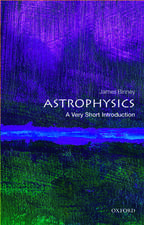The Physics and Evolution of Active Galactic Nuclei
Autor Hagai Netzeren Limba Engleză Hardback – 15 sep 2013
Preț: 492.77 lei
Preț vechi: 553.67 lei
-11% Nou
Puncte Express: 739
Preț estimativ în valută:
94.33€ • 97.07$ • 79.52£
94.33€ • 97.07$ • 79.52£
Carte tipărită la comandă
Livrare economică 28 februarie-14 martie
Preluare comenzi: 021 569.72.76
Specificații
ISBN-13: 9781107021518
ISBN-10: 1107021510
Pagini: 356
Ilustrații: 110 b/w illus. 16 colour illus. 12 tables
Dimensiuni: 183 x 261 x 21 mm
Greutate: 0.95 kg
Ediția:New.
Editura: Cambridge University Press
Colecția Cambridge University Press
Locul publicării:New York, United States
ISBN-10: 1107021510
Pagini: 356
Ilustrații: 110 b/w illus. 16 colour illus. 12 tables
Dimensiuni: 183 x 261 x 21 mm
Greutate: 0.95 kg
Ediția:New.
Editura: Cambridge University Press
Colecția Cambridge University Press
Locul publicării:New York, United States
Cuprins
Preface; 1. Observations of active galactic nuclei; 2. Nonthermal radiation processes; 3. Black holes; 4. Accretion disks; 5. Physical processes in AGN gas and dust; 6. The AGN family; 7. Main components of AGN; 8. Host galaxies of AGN; 9. Formation and evolution of AGN; 10. Outstanding questions; References; Index.
Recenzii
'Professor Netzer has produced a truly impressive text on the theory and observations of active galactic nuclei. He has done a superb job of bringing both clarity and depth to what has become in recent years a very broad and complex subject. This will undoubtedly become one of the field's defining texts and a primary resource for graduate students, their teachers, and researchers alike.' Mark Whittle, University of Virginia
'… the most complete single treatment of active galactic nuclei in the literature, with a remarkably broad view of the relevant physical processes and data. Netzer's text spans the intellectual range from basic theory to observational connections, better than any other treatment of AGN that I know of. This is especially important since the things we know with most assurance are observational, and the things we want to know are theoretical conclusions at various degrees of separation from the data; here one sees the whole chains of reasoning in rich detail. The text also folds in a range of recent developments, from the connections between accretion disks and outflows, through the rich statistics from recent sky surveys, to the unfolding links between AGN and their host galaxies as a normal part of galaxy evolution … a working reference, with useful tables and literature citations.' William C. Keel, University of Alabama
'… a rather splendid advanced textbook … It is authoritative and complete … if you want a single book that covers all the bases at graduate level, and gives you a jumping off point, this is the one.' The Observatory
'… the most complete single treatment of active galactic nuclei in the literature, with a remarkably broad view of the relevant physical processes and data. Netzer's text spans the intellectual range from basic theory to observational connections, better than any other treatment of AGN that I know of. This is especially important since the things we know with most assurance are observational, and the things we want to know are theoretical conclusions at various degrees of separation from the data; here one sees the whole chains of reasoning in rich detail. The text also folds in a range of recent developments, from the connections between accretion disks and outflows, through the rich statistics from recent sky surveys, to the unfolding links between AGN and their host galaxies as a normal part of galaxy evolution … a working reference, with useful tables and literature citations.' William C. Keel, University of Alabama
'… a rather splendid advanced textbook … It is authoritative and complete … if you want a single book that covers all the bases at graduate level, and gives you a jumping off point, this is the one.' The Observatory
Notă biografică
Descriere
A comprehensive introduction to the theory underpinning our study of active galactic nuclei and the ways we observe them.











